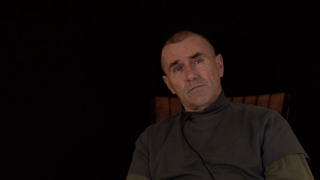8:48 | They had good intelligence from the Vietnamese that the Viet Cong were making a supply run down from their mountain base. Jim Benson's platoon got to the area, set up an ambush, and waited. They never came. They didn't come the next day either and the sleep deprived platoon went out for a third try. Part 1 of 2.
Keywords : Jim Benson Vietnam Bobans Provincial Reconnaissance Unit (PRU) Central Intelligence Agency (CIA) Phoenix Program Viet Cong (VC) Intelligence (Intel) Charlie Ridge rice ambush point man Reconnaissance (RECON) flare North Vietnamese Army (NVA) mortar

It was the "Sands of Iwo Jima" with John Wayne that inspired Jim Benson enough to leave a job he loved, coaching high school football, and join the Marines. It was 1968 so it was certain he would go to Vietnam. After the new Lieutenant recovered from the heat when he walked off the plane, he was assigned a platoon. He was surprised at what supplies were being packed for patrol.
It was his first patrol as a platoon leader and they were only a thousand yards out when Jim Benson encountered his first booby trap. He thought, is it this bad here? He found out that his platoon was not very disciplined, not even using flank security when moving. That all changed, but not before he lost a promising young corporal who ignored a basic rule.
His platoon was defending the Tu Cau Bridge when a Viet Cong came walking down the road right toward the machine gun emplacement. "Chu hoi," came the cry from the injured Vietnamese fighter and Jim Benson took him in and questioned him. A successful operation followed, marred only by some errant artillery shells that killed some civilians. This enraged his medic, who was not allowed to remain and treat the wounded.
Jim Benson's mission was to hold and guard the Tu Cau bridge. The work load on his men was heavy and he details the routine of patrols and ambushes, both day and night, that left the Marines exhausted. At the same time, he had to constantly train new replacements who had no combat knowledge.
It was already late and Jim Benson had a river crossing to deal with. Once there, he called for the rope, a vital piece of gear for the crossing. Private Dewey had forgotten the rope. Private Dewey was a train wreck, but when the shooting started, he was the man you wanted by your side. The next day, after a sleepless night with the listening post reporting movement, they made a startling discovery.
The platoon had just moved from the point position to the back of the column. Platoon leader Jim Benson walked up the column to speak to the next platoon's leader when the Viet Cong attacked and he was pinned down. One man rose to the occasion, Private Dewey, the unit's misfit.
After failing for three days to ambush a Viet Cong supply run, Jim Benson's unit was finally getting some sleep when word came, Charlie was moving. He reached the scene and, following a blood trail, he was just turning back when someone spotted a cave entrance. Part 2 of 2.
On Go Noi Island, a Marine company would secure an area, the bulldozers would clear it up to that point, and the Marines would advance some more. After his company's week was done, Jim Benson was going to warn the relieving officers and Amtrac drivers to take a different trail because he had smelled the enemy's pungent fish sauce on the trail. He was too late.
Jim Benson had been in the field for a long time getting thin on K-rations, that it only took a few beers to get him looped, and that's exactly what happened on the next R&R. Good thing he had an excellent sergeant looking out for him.
The Provincial Reconnaissance Unit men were a rough bunch. They were locals recruited by the CIA to help identify and eliminate Viet Cong and they were working with Jim Benson's Marine platoon. After a successful ambush, he was disturbed to find what the PRU's did with the enemy bodies. What he found following a blood trail made him distrust his own eyesight.
Platoon Leader Jim Benson loved to have Private Dewey around in a firefight but he was also the company misfit. When a new battalion commander took the reins, he laid down the law about accidental discharges. As the unit formed up in the field during an operation, the commander was standing right there when Dewey approached, the M79 Grenade Launcher in his hand.
Jim Benson figured out that the Viet Cong were going into a village at night to visit women there so he came up with a good technique to get them when they were coming out in the morning. Snipers would hide all night and set up before dawn to pick them off. This was working but two of the snipers got in trouble one morning and he set off with Doc Hargett to find them.
After some R&R in Hawaii, Jim Benson had duty with the battalion operations staff. This soon grew tiresome and he longed to get back into the field and command a platoon again. He was able to do that and more before he left Vietnam.
In Vietnam, the stress was just the beginning. Jim Benson describes the emotional states of the grunt on the ground in Vietnam. The lessons he learned and the qualities in men he admired are valuable to him.